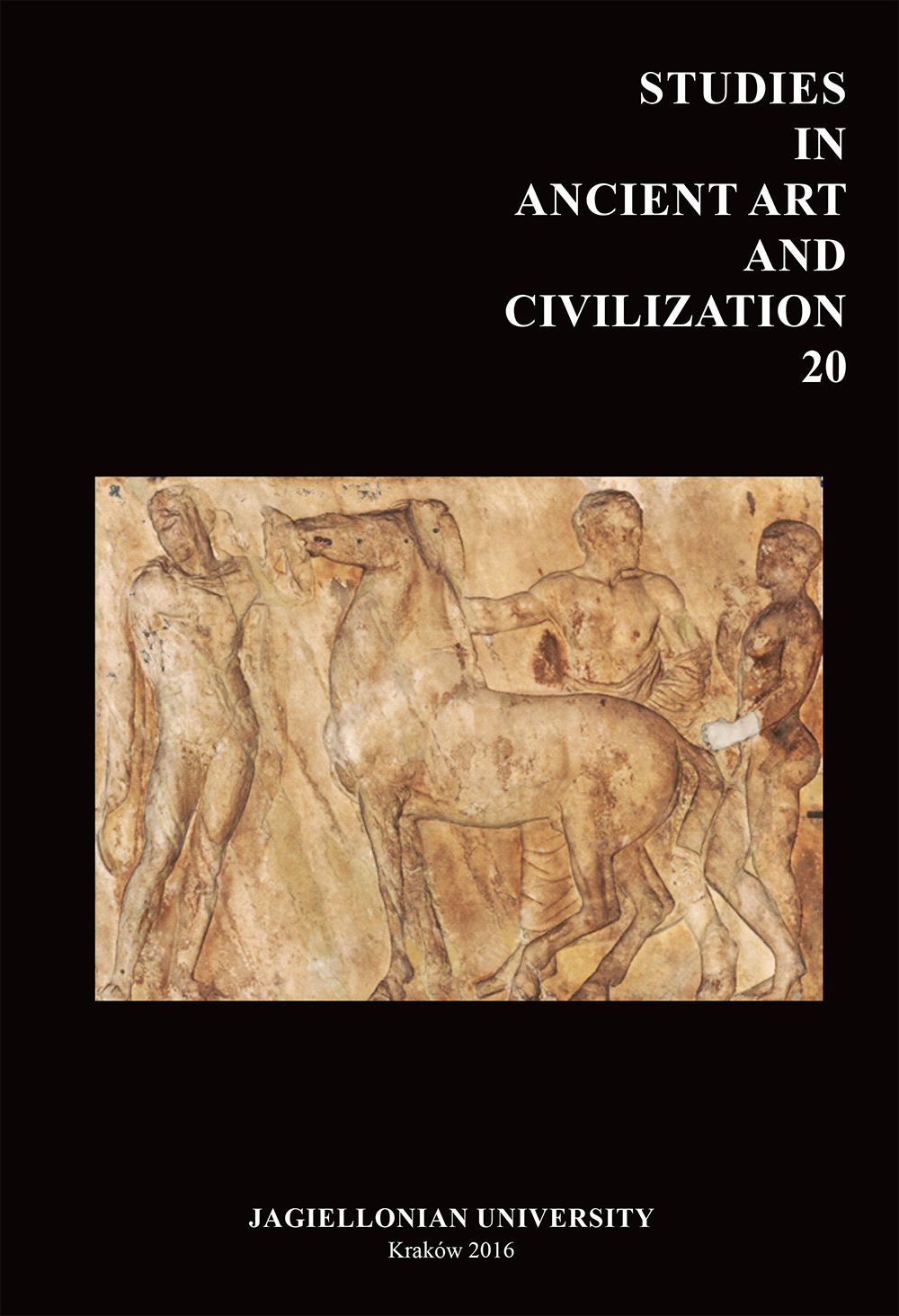Reconstruction of a Façade of the House of Aion, Nea Paphos, Cyprus
DOI:
https://doi.org/10.12797/SAAC.20.2016.20.10Keywords:
Nea Paphos, House of Aion, façade, architectural decoration, blind arcadeAbstract
The subject of this paper is a reconstruction of the architectural decoration of a façade of the House of Aion in Nea Paphos. During an excavation carried out in 1997 several pieces of decorated architectural elements were uncovered in room 19, among others the fragments of an arch, a lintel, an engaged column, an impost and two consoles. Those blocks served as a base for the reconstruction of the architectural frame of the main gateway. It took the form of a cantilevered, blind arcade of five spans erected above the main gate. Each span consisted of two engaged columns supporting an arch with a shallow niche underneath it, probably for a kind of decorative element. The reconstruction was based on similar architectural details known from the main room of the House of Aion, the Porta Aurea at the palace of Diocletian in Split, and the western façade of the Felix Romuliana Palace in Gamzigrad.
References
Adam R. 1764. The Ruins of the Palace of the Emperor Diocletian at Spalato in Dalmatia. London. DOI: https://doi.org/10.5479/sil.414240.39088006652358
Breitner G. 2011. Die Bauornamentic von Felix Romuliana/Gamzigrad und das tetrarchische Bauprogramm. In G. von Bülow and H. Zabehlicky (eds.), 143–152.
Bülow G. von and Zabehlicky H. (eds.) 2011. Bruckneudorf und Gamzigrad. Spätantike Paläste und Großvillen im Donau-Raum. Bonn.
Cambi N. 2005. Kiparstvo rimske Dalmacije. Split.
Czerner R. 2009. The Architectural Decoration of Marina el-Alamein. (BAR-IS 1492). Oxford.
Čanak-Medić M. 1978. Чанак-Медић M. Гамзиград, касноантичка палата. Архитектура и просторни склоп (résumé: Gamzigrad, palais bas-antique. Architecture et sa structuration). (Saopštenja 11). Belgrade.
Ćurčić S. 1993. Late-Antique palaces: the meaning of urban context. Ars Orientalis 23, 67–90.
Daszewski W. A. 1984. Fouilles Polonaises à Kato Paphos 1982. RDAC, 294–314.
Daszewski W. A. 1985. Dionysos der Erlöser. Griechische Mythen im spätantiken Cypern. Mainz.
Daszewski W. A. 1998a. Nea Paphos 1965–1995. In W. A. Daszewski and H. Meyza (eds.), 5–23.
Daszewski W. A. 1998b. Nea Paphos: Excavations 1997. Polish Archaeology in Mediterranean 9 (Reports 1997), 119–129.
Daszewski W. A. and Meyza H. (eds.) 1998. Cypr w badaniach polskich. Materiały z Sesji Naukowej zorganizowanej przez Centrum Archeologii Śródziemnomorskiej UW im. prof. K. Michałowskiego, Warszawa, 24–25 luty 1995. Warsaw.
Daszewski W. A. 1999. Nea Paphos: Excavations 1998. Polish Archaeology in Mediterranean 10 (Reports 1998), 163–173.
Daszewski W. A. apud Hadjisavvas 1998, 689–692.
Hadjisavvas S. 1998. Chronique des fouilles et découvertes archéologiques à Chypre en 1997. BCH 122/2, 663–703. DOI: https://doi.org/10.3406/bch.1998.7195
Hébrard E. and Zeiller J. 1912. Spalato. Le palais de Dioclétien. Paris.
Lichocka B. and Meyza H. 2001. Seismic events and the evidence of coins and pottery. The case of destruction of the House of Aion in Paphos. ÉtTrav 19, 145–208.
Lyttelton M. 1974. Baroque Architecture in Classical Antiquity. New York.
Marasović J. and Marasović T. 1968. Der Diokletianspalast. Zagreb.
McKenzie J. 2007. The Architecture of Alexandria and Egypt. C. 300 B.C. to A.D. 700. New Haven, London.
McNally S. 1996. The Architectural Ornament of Diocletian’s Palace at Split. (BAR-IS 639). Oxford. DOI: https://doi.org/10.30861/9780860548232
Medeksza S. 1987. Reconstruction works in the ‘House of Aion’ in Nea Paphos. RDAC, 227–230.
Medeksza S. 1998. Willa Tezeusza w Nea Pafos na Cyprze: powstanie i fazy rozwoju. In W. A. Daszewski and H. Meyza (eds.), 25–50.
Mikocki T. 1992. Essai de reconstruction du Mur Ouest de la salle I dans la ‘Maison d’Aion’ à Nea Paphos. ÉtTrav 16, 135–150.
Nikśić G. 2011. Diocletian’s Palace – design and construction. In G. von Bülow and H. Zabehlicky (eds.), 187–202.
Nikšić G. 2004. The restoration of Diocletian’s Palace – Mausoleum, Temple, and Porta Aurea (with the analysis of the original architectural design). In A. Demandt, A. Goltz and H. Schlange-Schöningen (eds.), Diokletian und die Tetrarchie. Aspekte einer Zeitenwende. Millenium-Stud. Kultur u. Gesch. Ersten Jts. n.Chr. 1, 163–171. Berlin, New York.
Nomination 2005. Gamzigrad – Romuliana Palace of Galerius. Nomination of Archeological Site for Inclusion on The World Heritage List. Nomination Dossier Compiled by the Institute for Protection of Cultural Monuments of Serbia, 14, 27, 65. 2005. Retrieved from http://whc.unesco.org/uploads/nominations/1253.pdf (status as of Feb. 26th, 2016).
Rekowska M. 2012. Architectural decoration of the House of Leukaktios: preliminary remarks. In J. Żelazowski (ed.), Ptolemais in Cyrenaica. Studies in Memory of Tomasz Mikocki, 157–181. Warsaw.
Ward-Perkins J. B. 1994. Roman Imperial Architecture. New Haven, London.






